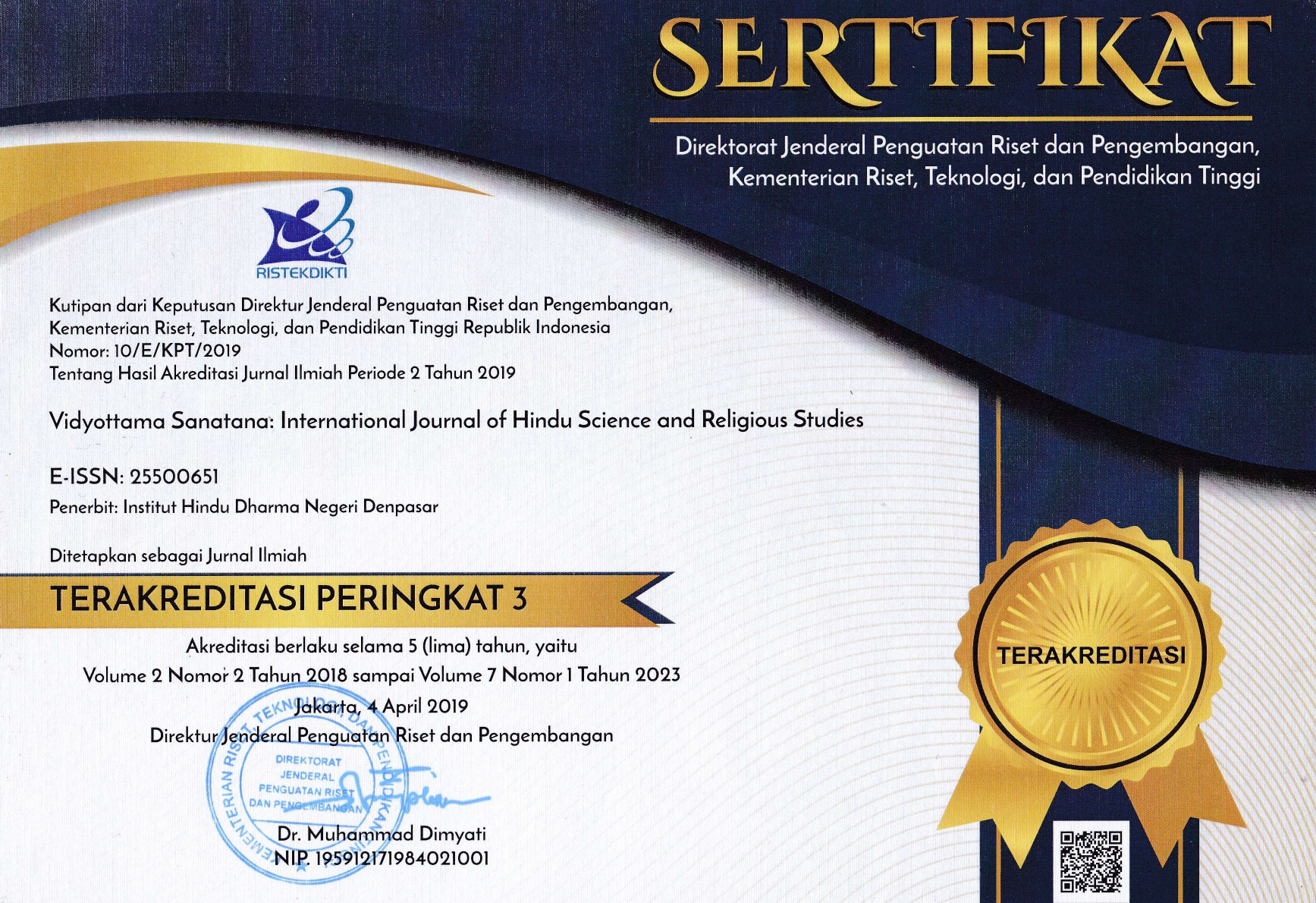BATU PULAKI AND ITS IMPLICATIONS FOR THE LIVES OF BALINESE PEOPLE
DOI:
https://doi.org/10.25078/vidyottama.v8i1.3130Keywords:
socio-religious analysis, implications, existence, pulaki stoneAbstract
Batu Pulaki is a stone that is a manifestation of Bali's natural wealth as well as a heritage in the cultural life of the people of Bali. Knowledge of the types, contents, functions and their relationship with the people in Bali. This study aims to describe in more detail the Batu Pulaki its implications for the lives of Balinese people context of the people of Bayupoh Village. To explain the problem above the author uses a type of qualitative research. In this case, the authors were directly involved in data collection by means of observation, documentation, and interviews with informants in the Pulaki area of Bali. In addition, this research uses types of library data such as books, theses, journals, internet media, and so on that supports research. To answer the problem, researchers used Structural Functional Theory. From the research conducted, the findings were obtained, namely the existence of Pulaki stones in a sacred area in which there is the Agung Pulaki temple and several Pasanakan temples around the Pulaki temple. This shows that the Pulaki region with several temples there as relics of Hindu civilization is a center of social and spiritual activity. Pulaki as a sacred area and Pulaki stone as a symbol of community religious ritual facilities historically and theologically provide an aid in understanding religion to the community. The people of Banyupoh Village use Pulaki stones for pedagingan and panca datu, apart from that the existence of Batu Pulaki is also used as a shrine, as a medium of worship by the Hindu community in Banyupoh Village. In its innovation and development, Pulaki stone has been transformed into several art products such as accessories, water fountains and various types of sculptural art.
References
Boty, M. (2015). Analisis Fenomena Sosial Batu Akik (Studi Pada Masyarakat (Penjual- pembeli) Di Pusat Penjualan Batu Akik Palembang). Jurnal Ilmu Agama: Mengkaji Doktrin, Pemikiran, dan Fenomena Agama, 16(2), 81-102.
Geria, I Made. 2008. Kearifan Lokal dalam Pengelolaan Lingkungan di Bali (Kajian dari data Arkeologi). Jakarta: Ikatan Ahli Arkeologi Indonesia (IAAI). Hal 89-94.
Hamid, I. (1991). Masyarakat dan budaya Melayu. Dewan Bahasa dan Pustaka.
I Gusti Ngurah, A. J. C. (2012). Comodification of Form of Pepalihan and Ragam Hias Wadah Created by Ida Bagus Nyoman Parta at Angantaka Village, Badung Regency. Mudra (Jurnal Seni Budaya), 27(2), 1-1.
Ishomuddin, I. (2015). Involvement of higher education in building human resources character in the era of globalization. International Education Studies, 8(11), 148-155.
Karyasa, I. W., Muderawan, I. W., & Rai, I. W. (2015, October). Karakterisasi Batu Mulia Badar Pulaki. In Prosiding Seminar Nasional MIPA.
Koentjaraningrat (1997). Manusia dan Kebudayaan di Indonesia.Jambatan: Jakarta
Maswinara, I. W. Wayan, 2010. Srimad Bhagavad-Gita. Surabaya: Paramitha dalam Kodam Jayakarta.
Muhni, D. I. (1994). " Charitable gambling" in American culture: an ethnographic study of bingo and poker players. (No Title).
Rai, I. W., Muderawan, I. W., & Karyasa, I. W. (2014). Revitalisasi Kerajinan Batu Permata Pulaki. Ngayah: Majalah Aplikasi IPTEKS, 5(2), 155563.
Soekanto, S. (2012). An Introduction to sociology. RajawaliPress, Jakarta.
Syakhrani, A. W., & Kamil, M. L. (2022). Budaya Dan Kebudayaan: Tinjauan Dari Berbagai Pakar, Wujud-Wujud Kebudayaan, 7 Unsur Kebudayaan Yang Bersifat Universal. Cross-border, 5(1), 782-791.
Penyusun, T. (1994). Buana Kosa Alih Aksara dan Alih Bahasa [Brahma Rahasyam]. Denpasar: Upada Sastra.
Putrawan, I. M. (2015). Measuring new environmental paradigm based on students knowledge about ecosystem and locus of control. EURASIA Journal of Mathematics, Science and Technology Education, 11(2), 325-333.
Vivekananda, S. (1991). Bhakti yoga: The yoga of love and devotion. Advaita Ashrama (A publication branch of Ramakrishna Math, Belur Math).
Weber, P. A., Stewart, W. A., Skinner, W. M., Weisener, C. G., Thomas, J. E., & Smart, R. S. C. (2004). Geochemical effects of oxidation products and framboidal pyrite oxidation in acid mine drainage prediction techniques. Applied Geochemistry, 19(12), 1953-1974.
Yuliani, M. (2018). Dampak Penambangan Batu Gunung Di Desa Merangin Kecamatan Kuok Ditinjau Menurut Ekonomi Islam. Syarikat: Jurnal Rumpun Ekonomi Syariah, 1(2), 90-101.


















